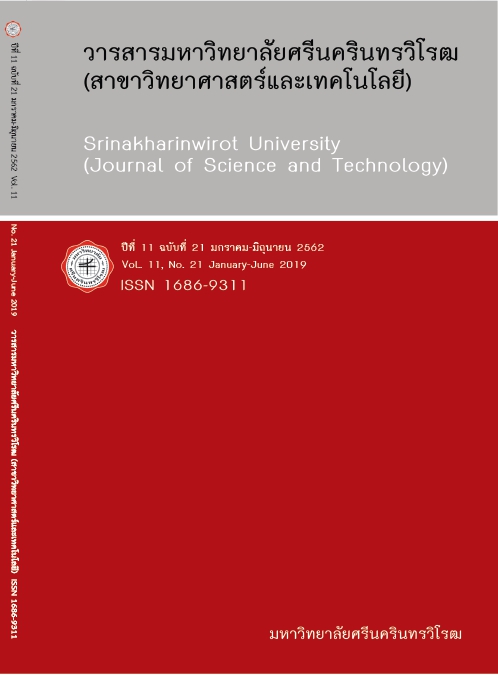การประเมินศักยภาพการผลิตพลังงานไฟฟ้าจากเซลล์แสงอาทิตย์บนหลังคาโดยใช้แบบจำลองทางคณิตศาสตร์: กรณีศึกษา อาคารสำนักวิทยบริการ มหาวิทยาลัยมหาสารคาม EVALUATION OF ELECTRICITY GENERATION POTENTIAL FROM SOLAR ROOFTOP USING THE MATHEMATICAL MODEL: CASE STUDY OF ACADEMICS RESOURCE CENTER BUILDING, MAHASARAKHAM UNIVERSITY
Keywords:
Solar Rooftop, Solar Radiation, Evaluation of PotentialAbstract
The purpose of this research is to evaluate the electricity generation potential from solar rooftop under a condition of solar radiation following a roof direction of the academic resource center building (A building), Mahasarakham University, Khamriang campus, Kantharawichai district, Mahasarakham province. The mathematical model on Microsoft Excel program was used in this analysis. The methods of the research are as follows: (1) the building plan analyzing by AutoCAD program was used in the evaluation of geographic potential; (2) the solar radiation data from the solar measurement station of faculty of engineering, Mahasarakham University was used in the evaluation of solar radiation potential following the roof direction; (3) the solar radiation data, the ambient temperature data from 4 meteorological station, Khon Kaen and Roi Et province, and the fundamental property of the solar cell, type of SW 285-300MONO (5-busbar) were used in the evaluation of power and electricity; and (4) the evaluation of array yield. The standard of international energy agency (IEA-PVPS T2-03:2002) was used in an evaluation of electricity generation potential from the solar rooftop. The result of this potential has been shown with the geographic information system. The total area of the A building has been found that 2,744.00 m2, and It has been classified in 6 directions. There are 165 (NE1), 75 (SE2), 30 (SE1), -15 (SW1), -105 (NW1) and -150 (NW2). The total solar roof installation is 972 panels, and the total power is 291.60 kW. The highest average solar radiation of SW1, SE1, NW1, SE2, NW2, and NE1 are 5.84, 5.61, 5.30, 5.19, 4.72 and 4.45 kWh/m2-d, respectively. Hence it affects the value of array yield (Ya) is 154.86, 148.54, 139.08, 136.88, 122.35 and 114.97 kWh/kWp, respectively. The highest electric potential of SE1, NW1, NW2, SW1, NE1, and SE2 are 100.53, 86.62, 75.76, 74.15, 71.61 and 65.54 MWh/y, respectively. The total electricity is 474.20 MWh/y. Therefore, the evaluation of electricity generation potential from the solar rooftop is important to find out the highest array yield position.
Downloads
References
[2] International Energy Agency. (2017). Annual Report 2016. France: IEA Photovoltaic Power Systems Programme (PVPS).
[3] Natthapong Suwanasang; and Sopitsuda Tongsopit. (2015). An Assessment of the Technical and Economic Potential of Rooftop Solar Systems on Chulalongkorn University’s Buildings. Journal of Energy Research. 12(2): 59-74.
[4] Perawut Chinnavornrungsee.; et al. (2015). Evaluation of Rooftop Solar PV Performance of Different PV Module Technologies Operating in Thailand. Ladkrabang Engineering Journal. 32(2): 19-24.
[5] Nipon Ketjoy; and Kongrit Mansiri. (2010). Technical Performance Study of 6.52 kW Photovoltaic Grid Connected System. Naresuan University Journal. 18(3): 27-35.
[6] Emmanuel Kymakis.; et al. (2009). Performance Analysis of a Grid Connected Photovoltaic Park on the Island of Crete. Energy Conversion and Management. 50(3): 433-438.
[7] Bakirci Kadir. (2012). General Models for Optimum Tilt Angles of Solar Panels: Turkey Case Study. Renewable and Sustainable Energy Reviews. 16(8): 6149-6159.
[8] Basharat Jamil.; et al. (2016). Estimation of Solar Radiation and Optimum Tilt Angles for South-Facing Surfaces in Humid Subtropical Climatic Region of India. Engineering Science and Technology, an International Journal. 19(4): 1826-1835.
[9] Taehoon Hong.; et al. (2014). A GIS (Geographic Information System)-Based Optimization Model for Estimating the Electricity Generation of the Rooftop PV (Photovoltaic) System. Energy. 65: 190-199.
[10] T. Santos.; et al. (2014). Applications of Solar Mapping in the Urban Environment. Applied Geography. 51: 48-57.
[11] Muhammad Iqbal. (1983). An Introduction to Solar Radiation. New York: Academic Press.
[12] Muneer; and Saluja. (1985). A Brief Review of Models for Computing Solar Radiation on Incline Surfaces. Energy Conversion and Management. 25(4): 443-458.
[13] P.I. Cooper. (1969). The Absorption of Solar Radiation in Solar Still. Solar Energy. 12(3): 333-346.
[14] Serm Janjai. (2017). Solar Radiation. 2nd ed. Nakornpathom: Phetkasem Printing Group.
[15] Map of World. (2017). Thailand Latitude and Longitude Map. Retrieved December 13, 2017, from http://www.mapsofworld.com/lat_long/thailand-lat-long.html
[16] B. Minnaert; and P. Veelaert. (2014). A Proposal for Typical Artificial Light Sources for the Characterization of Indoor Photovoltaic Applications. Energies. 7(3): 1500-1516.
[17] Eco Direct. (2017). 300 Watt Mono Solar Panel. Retrieved December 13, 2017, from https://www.ecodirect.com/SolarWorld-SW300-Plus-Mono-5BB-300W-Mono-Panel-p/solarworld-sw300-plus-mono-5bb.htm
[18] Wutthisat Chokkuea. (2013). Parabolic Trough Solar Thermal Electric Power Plant for House. Doctor of Philosophy, Ph.D. (Mechanical Engineering). Mahasalakham: Graduate School Mahasalakham University.
[19] Thai Meteorological Department (TMD). (2018). Weather Classified by City. Retrieved December 13, 2017, from http://www.aws-observation.tmd.go.th
[20] Volker Quaschning. (2005). Understanding Renewable Energy Systems. London: Earthscan.
[21] Antonio Luque; and Steven Hegedus. (2011). Handbook of Photovoltaic Science and Engineering. 2nd ed. New York: John Wiley & Sons.
[22] R.G. Ross; and M.I. Smoklre. (1986). Flat-Plate Solar Array Project: Final Report, Volume VI: Engineering Sciences and Reliability. USA: Jet Propulsion Laboratory.
[23] International Energy Agency. (2001). Operational Performance, Reliability and Promotion of Photovoltaic Systems. Germany: IEA Photovoltaic Power Systems Programme (PVPS).
Downloads
Published
How to Cite
Issue
Section
License
Srinakharinwirot University Journal of Sciences and Technology is licensed Under a Creative Commons Attribution-NonCommercial-NoDerivs 4.0 International (CC-BY-NC-ND 4.0) License, Unless Otherwise Stated. Please Read Journal Policies Page for More Information on Open Access, Copyright and Permissions.



